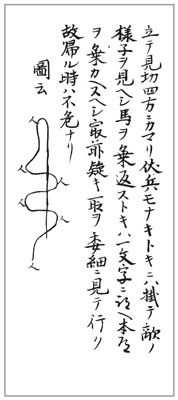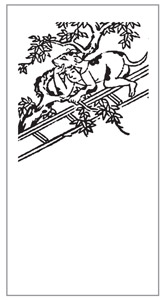In Search of the Niinja (25 page)
Read In Search of the Niinja Online
Authors: Antony Cummins

The basic premise was to follow an undulating route and periodically stop and rear the horse and search for ambushes and
Kamari
who are lying in the grass. In the image this is displayed by the ideogram for person at the points of turning.
at the points of turning.
If you venture out on mounted scouting run by yourself you should take a ‘weaving’ pattern and keep your posture low. Then investigate closely suspicious areas or in those places that need to be examined closely, at such places you should make your horse rear up so that you can look in all directions and if there are no
Kamari
or ambush troops you should proceed and observe the enemy’s situation. When you return you should take a straight route as you have already cleared that area on your way through, thus you will be safe on the way back.

Scouting to find ambushes.
Dakko

Dakko
is possibly the greatest contender for a direct skill from ancient China to have reached Japan. The Chinese classics when referring to spies do so with an emphasis on the art of
Yo-nin
, that is the art of open disguise and immersion into the enemy culture as opposed to stealing in and remaining hidden from view. The art of
Dakko
is the ability to understand and merge with the enemy, to have the power to fool those of a province that you are one of them. Whilst less dramatic then other ninja skills, it is clearly a skill that can only be achieved to a high level by a select few. The rigorous training and preparation is daunting and even the ninja Natori Masatake states the difficulty in his monograph:
Originally, the skill of
Dakko
was to imitate the dialects of more than 60 provinces with a great fluency. Those skilled knew and were aware of all the points of interest, historic spots and famous places of natural beauty within each area. Thus, it is called
Dakko
– depriving the world with your mouth.
The
Kusonoki-ryu
70
Ninpo Dakko Shinobi
annotated
scroll discusses the three major forms of
Dakko
that a shinobi of that school would be required to know:
1 To ‘deprive the world by mouth’, that is to have the ability to understand multiple dialects and to move around freely in the world, gathering information by using your understanding of the local language and customs to infiltrate an area and gather what is required.
2 To ‘steal from the world through the mouth’, that is, to listen to the conversations of others and to go unnoticed as you gather information by allowing the conversations of others to supplement you with the information you require.
3 To ‘take advantage of the way people talk and to live in lies’. This third point refers to the concept that you will use the conversations of others to take advantage of any situation and bring about your intended goal by manipulating situations and people to your own advantage, whilst you yourself live as a lie, you never reveal who you are, what you think or even your own thoughts, the aim is to remove your personality from the equation and maintain a life of lies with a final goal in mind.
Both the
Shoninki
and the
Dakko Shinobi No Maki Ryakuchu
scrolls talk about sending a shinobi as a messenger to the enemy to find out their secrets and to gather information on their formations. This is a part of the skill of
Dakko
and relies on the shinobi, no matter what his social status, appearing as a
Chu-nin
servant of an ambassador to the enemy. Once in the enemy camp he is mainly ignored as a lower person and maybe even quartered with the servants. It is clear from the writings that this ‘servant’ would have free rein in the public areas of the camp and be allowed to interact with the enemy.
The
Toryu Shinobi No Maki
scroll is heavily based on Chinese thought and the system of the five spies and is considered to be connected to
Natori-ryu
. The scroll itself lists the 139 ways of
Dakko
. Unfortunately this list is a selection of mnemonics or prods to be used to pass on
Kuden,
or oral tradition. The inventory includes:
•
Detaching from desire
•
Concealing the ego
•
How to use the common methods of people
•
The keeping of a calm mind
•
The art of knowing if people speak the truth
•
Shinobi used as scouts
The word
Dakko
in this scroll is used specifically to mean
shinobi no jutsu
or the art of spying but overall
Dakko
is the art of information gathering by taking advantage of other people’s speech and collecting information in all the ways you can and then constructing a picture of the enemy’s plans.
Kyodo
Kyodo
is at times referred to as a skill and at other times a person. It means using a local person (or someone planted as an undercover agent) to gather information about the area you wish to infiltrate or investigate; a mundane skill perhaps, yet an important one for the shinobi when gathering information, This would constitute a high percentage of the ninja’s work, listening and talking to locals as he makes his way through the enemy province. The
Heiho Nukigaki Hippu No Sho Gunshi No Maki
states:
Of Kyodo and Guidance:
This is a [person who is a] guide for you in your enemy’s province. It is desirable to place one there beforehand or [at least] have one in the enemy province when needs arise.
There are multiple references to the ninja using animal skins to help in their infiltration and are not for the squeamish. The idea is that an agent will gut a monkey, dog, fox or Japanese ‘racoon’ and use the striped skin and head to change his outline. It is a misconception that the ninja make a ‘monkey suit’ and pretend to be a monkey. The actual skill is to aid a ninja climb through trees in a garden without being noticed. The ninja of Japan were small, but even at less than five feet in stature, the monkeys of Japan are smaller. In truth, the idea is most likely that a ninja would use the skin of a monkey and drape it over his head and shoulders whilst he shimmied along branches. If this movement was seen, then the observer would in fact see a silhouette against the sky or even the shape of a monkey’s head in the branches of the tree and hopefully would simply pass it off as local wildlife. In this manner other animals were used depending on the situation. Larger animals, such as smaller species of bear, were quite hefty in comparison to the medieval Japanese so a ninja would disembowel the animal and drape the entire skin over his frame and move along the edges of camps or buildings. Examples of this skill do exist outside of ninja manuals and even find their way into art, as seen here. This skill must not be confused with the art of
sounding
like a dog, which is a method to attract the attention of people inside of a house to establish their whereabouts.

The ninja image used in the
Wakan Sunsaizuai
encyclopaedia shows the skill of using an animal skin to infiltrate an area. However, this could also be a reference to specialist ninja who infiltrate being known as ‘Dogs’.
A selection of various ninja manuals talk of a form of sleeping powder, such as the
Iga Ninhi no Kan
, the
Bansenshukai
, the
Ninpo
Hikan
and the
Shinobi
No
Maki
Te
Kagami
. The latter has details about the sleeping powder:
Tradition says if you inhale [sleeping medicine/powder
71
] you will become intoxicated and fall asleep. If you are going to use it [whilst stealing in] you should first burn and inhale incense at a distance from the target house, this will prevent you from succumbing to the effects of the sleeping medicine/powder.
Generally the idea is to soak paper (or material) in the blood of certain animals and add a ‘secret’ ingredient into the mix, which is normally a form of insect or parasite, such as the worms found in human excrement. The paper is then dried and rolled up. When this is ignited it is placed in an enclosed guardroom: ‘They will become intoxicated and fall asleep.’
Some manuals discuss amphibians such as newts whilst the
Bansenshukai
recommends the blood of a brown dog. Similar potions exist in medieval European literature. Even though full experimentation has not been undertaken, a chemical analysis can be performed on the ingredients themselves.
At first glance, the ninja ‘Sleeping Medicine’ appears to be medieval madness, however, according to the theoretical
72
analysis by Alex Allera of the Chemistry Department of Turin University, there may be more to it.
Soaking animal
73
blood (especially blood of the liver) into paper and combusting it in an enclosed area could produce the drowsy effects described in the manuals.
A breakdown of the chemicals that could have ‘drowsy effects’ that are present in just the paper itself, without the other elements, produces carbon monoxide (CO), which comes from the combustion.
A breakdown of the chemicals that have drowsy or harmful effects and are present in blood and its subsequent combustion are as follows:
•
ammonia (NH3) – negligible amounts
•
nitrogen oxides (NOx)
•
sulphur oxides (SOx)
The combustion of the amino acids present in the blood would create the following elements:
•
nitric oxide (NO)
•
ipoazotide or nitrogen dioxide (NO
2
or N
2
O
4
)
•
nitrous oxide (N
2
O)
•
dinitrogen trioxide or nitrous anhydride (N
2
O
3
)